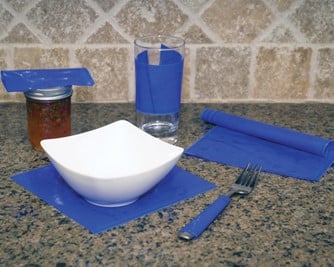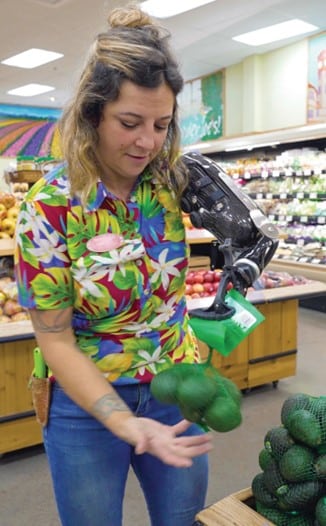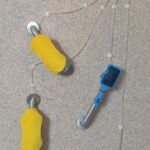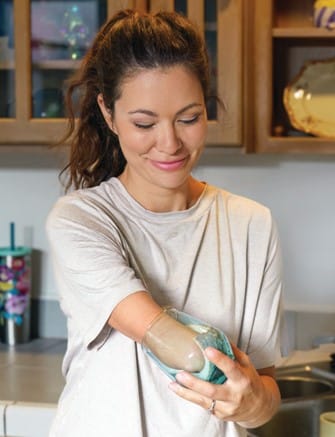By Sherri Edge and Amber Henson
People who live with upper limb differences understand very well what it means to innovate. If you’re missing your arm or part of your hand, almost everything you want to do has to be approached from a different perspective. Some people figure out how to live life with one hand and don’t use a prosthetic device. Others discover that wearing a prosthesis can make it easier to get things done and reduce overuse of their sound arm and hand. We asked some upper limb amputees to share their favorite life hacks and shortcuts for getting things done, both with and without their prosthesis.

Kristi Wolfgram and daughter
Here are a few of her cooking and kitchen hacks. “I find kitchen gadgets that help with chopping, slicing and opening jars. You can use a pizza cutter for much more than pizza! Pampered Chef has a lot of great kitchen gadgets, but you can find items at other online retailers as well.” Here’s an easy solution for spice enthusiasts: “An electric pepper grinder works great for rock salt as well as pepper. The manual twist grinders are hard to use with or without a prosthesis.”
Kristi Wolfgram has a congenital limb difference and has worn a prosthesis on her lower arm since she was six months old. She has a lot of experience figuring out how to do things for herself and her seven-year-old daughter, Aria.

Dycem® non-slip
“I use Dycem® non-slip all the time. You can buy it in mats or rolls and put it under cutting boards to stabilize or to help open jars,” Kristi says.

Wendi’s Avocado Bagging Tip
After shattering her elbow in a snowboarding accident, Wendi Parker got good at doing things with one hand, like stocking the shelves at Trader Joe’s where she works. She thought it was temporary, but following a series of medical complications, she had an above-elbow amputation. Wendi’s prosthetic team at Arm Dynamics designed a prosthesis that gives her more range to come up with hacks for work. Her device has an external hinged ‘elbow’, and she can attach different terminal devices depending on what task she’s doing.
For example: “Instead of holding a broom with my hand, it works better for me to slide it through the elbow hinge. It’s easier to sweep and I can use my right hand to hold the dustpan.”
It was a big deal at work when she found a way to “spin and stack” bags of avocados again. “I hold the bag with my V2P, spin it with my right hand, and stack them up nice and pretty.”

Gerry’s Shower
Gerry Kinney is the epitome of finding a way. He was a lineman for 20 years before making contact with an electrical line and losing both his arms below the elbow. Gerry wears his prostheses at least eight to ten hours each day, but when he takes them off to shower, he’s got a few tricks up his sleeve.
“My shower has three aluminum grab bars on the wall at different heights and angles,” he says. “Two of them hold sponges for washing my body and one holds a hairbrush to help me shampoo my hair.” His set-up also includes a soap/shampoo dispenser that moves the liquids right onto the sponges and hairbrush. “My shower is designed to allow me to do things on my own, and I love that.”
Growing up with a congenital limb difference, Shaholly Ayers has used a prosthesis off and on for most of her life. Like Gerry, she’s come up with some creative ways of getting things done when she’s not wearing her prosthesis. “When I worked in retail, I would stack hangers on my right arm and go return clothes to the racks,” she says. “I still do that sometimes at home, when I’m putting clothes away.”

Shaholly Glass Washing Tip.
Here’s her hack in the kitchen: “I hold the glass with my left hand and use my shorter right arm to push a soapy sponge down into the glass.”
Shaholly uses two prostheses, an activity-specific and a myoelectric. “When I’m holding something like a plate or a cup with my bionic hand, one of my favorite hacks is to turn off the arm,” she says. “Then I’m not concerned about accidentally triggering an electrode, and I can also save some battery power.”
While a prosthesis can make it quicker and easier for people to get things done, this world is built for those with two sound hands. People with limb differences must figure out how to adapt and innovate. We hope that readers find the above hacks helpful or are perhaps inspired to come up with their own.


